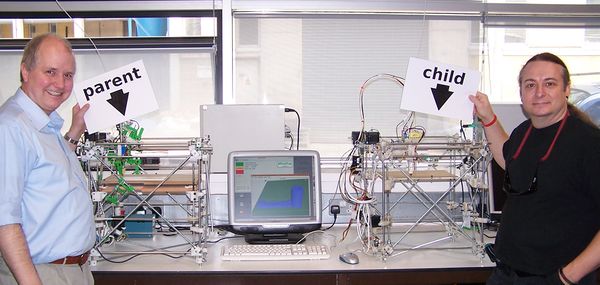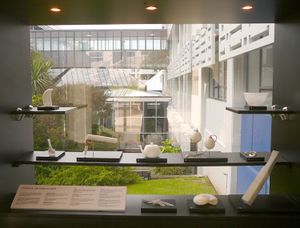About/nl
Translations of this page
Nederlands: Over Mendel Nederlands
Contents
Het Concept
Kijk naar je computer en stel je voor dat je een 3D printer had aangesloten. In plaats van het printen op papier, maakt deze 3D printer het mogelijk om robuuste mechanische onderdelen te maken. Je moet dan denken aan de robuustheid van lego stenen. Je kunt een hoop bruikbare dingen maken, maar het is ook mogelijk om de onderdelen van een andere 3D printer te maken. Dat zou een 3D printer zijn die zichzelf kan kopieren.
De Realisatie
<videoflash type="vimeo" width="400" height="320">5202148</videoflash>
RepRap is de afkorting voor Replicating Rapid-prototyper. Het is de practische zelf-replicerende 3D printer welke links wordt geintroduceerd in de video. De 3D printer bouwt de onderdelen op in laagjes plastic. Deze technologie bestaat, maar de goedkoopste machine op de commerciele markt zou ongeveer €30,000 kosten. En het is niet gemaakt om zichzelf te kunnen nabouwen. Het RepRap team ontwerpt en stelt de ontwerpen beschikbaar voor een veel goedkopere machine dat wel in staat is zichzelf te repliceren. (materiaalkosten ongeveer €350). Nu is het mogelijk voor zowel kleine communities in de derde wereld als individuen in de 'eerste' wereld om 3D printers te maken. De principes van de 'Free Software Movement' volgend publiceren we de ontwerpen van de RepRap machine voor iederen volgens een open source license (the GNU General Public Licence). Dus, als je een RepRap machine bezit kun je het gebruiken om een andere te printern en te geven aan je een vriend...
De RepRap project werd algemeen bekend na veel aandacht in de pers in maart March 2005. Het idee werd echter al beschreven in een paper op het Internet geschreven door Adrian Bowyer op 2 February 2004.
Machine Self-Replication
Not counting nuts and bolts RepRap can make 50% of its parts; the other parts are designed to be cheaply available everywhere. The primary goal of the RepRap project is to create and to give away a makes-useful-stuff machine that, among other things, allows its owner cheaply and easily to make another such machine for someone else.
To increase that 50%, the next version of RepRap will be able to make its own electric circuitry - a technology we have already proved experimentally - though not its electronic chips. After that we'll look to doing transistors with it, and so on...

Scholarship
Academics and others seeking refereed journal articles on RepRap may care to start with this paper in Robotica. The citation and link are:
Jones, R., Haufe, P., Sells, E., Iravani, P., Olliver, V., Palmer, C., and Bowyer, A.,: RepRap – the replicating rapid prototyper, Robotica (2011) volume 29, pp. 177–191. Cambridge University Press.
If you are interested in the legal aspects of this technology, then you may care to read this paper:
Bradshaw, S., Bowyer, A. and Haufe, P.: The Intellectual Property Implications Of Low-Cost 3D Printing, ScriptEd, April 2010 pp.5-31.
Glossary
- RepRap - n. any free rapid prototyping machine that can manufacture a significant fraction of its own parts; v.t. (in lower case: to reprap) to make something in a RepRap machine.
- RepStrap - n. any free rapid prototyping machine that doesn't make its own parts, but is intended to make parts for a RepRap.
- reprapper - n. a person engaged in making or using RepRaps or RepStraps.
- reprapable - adj. capable of being made in a RepRap machine.
